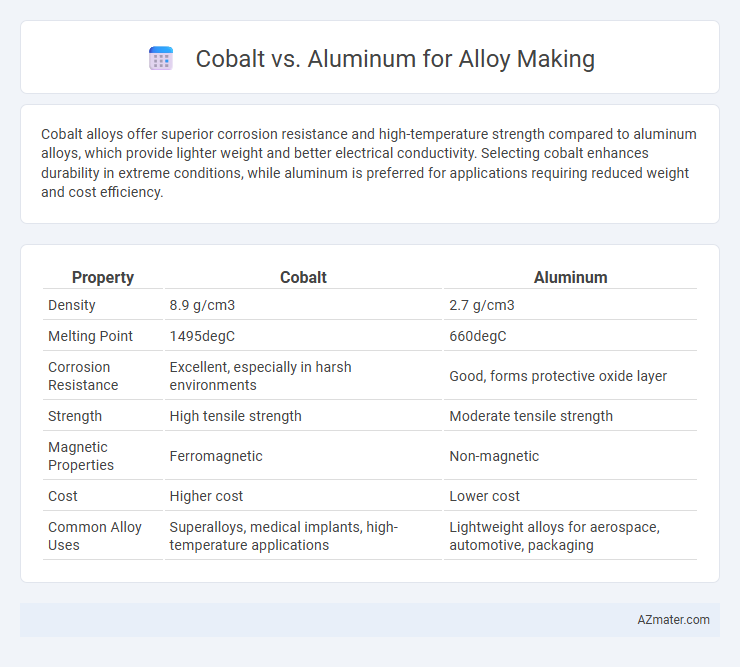Cobalt alloys offer superior corrosion resistance and high-temperature strength compared to aluminum alloys, which provide lighter weight and better electrical conductivity. Selecting cobalt enhances durability in extreme conditions, while aluminum is preferred for applications requiring reduced weight and cost efficiency.
Table of Comparison
| Property | Cobalt | Aluminum |
|---|---|---|
| Density | 8.9 g/cm3 | 2.7 g/cm3 |
| Melting Point | 1495degC | 660degC |
| Corrosion Resistance | Excellent, especially in harsh environments | Good, forms protective oxide layer |
| Strength | High tensile strength | Moderate tensile strength |
| Magnetic Properties | Ferromagnetic | Non-magnetic |
| Cost | Higher cost | Lower cost |
| Common Alloy Uses | Superalloys, medical implants, high-temperature applications | Lightweight alloys for aerospace, automotive, packaging |
Introduction to Cobalt and Aluminum in Alloy Making
Cobalt and aluminum are essential metals used in alloy making, prized for their unique properties and applications. Cobalt alloys are renowned for high-temperature strength, corrosion resistance, and magnetic properties, making them ideal for aerospace, medical implants, and turbine components. Aluminum alloys offer lightweight, excellent corrosion resistance, and high conductivity, widely used in automotive, aerospace, and construction industries for enhancing strength-to-weight ratios.
Chemical Properties: Cobalt vs Aluminum
Cobalt exhibits excellent chemical stability with high resistance to oxidation and corrosion, maintaining integrity at elevated temperatures, making it ideal for high-performance alloys. Aluminum is lightweight and forms a protective oxide layer that prevents further corrosion, but it has lower melting points and chemical resistance compared to cobalt. The choice between cobalt and aluminum in alloying depends on the required chemical durability and thermal stability of the final material.
Mechanical Strength Comparison
Cobalt alloys exhibit superior mechanical strength compared to aluminum alloys, especially in high-temperature applications where cobalt maintains structural integrity and creep resistance. Aluminum alloys, while lightweight and corrosion-resistant, generally show lower tensile strength and hardness, making them less suitable for heavy-duty or high-stress environments. The high density and strong wear resistance of cobalt alloys make them ideal for aerospace and medical implant components where enhanced durability is crucial.
Heat and Corrosion Resistance
Cobalt alloys exhibit superior heat resistance with melting points around 1495degC and excellent stability at high temperatures, making them ideal for aerospace and turbine applications. Aluminum alloys offer moderate heat resistance, generally melting near 660degC, but excel in corrosion resistance due to their natural oxide layer that protects against oxidization and weathering. When balancing heat and corrosion resistance, cobalt alloys outperform aluminum in thermal endurance, while aluminum alloys provide lightweight corrosion protection suitable for marine and automotive environments.
Weight and Density Differences
Cobalt alloys typically exhibit higher density, around 8.9 g/cm3, compared to aluminum alloys which range between 2.6 to 2.8 g/cm3, resulting in significantly heavier components. The weight difference impacts applications where minimizing mass is crucial, favoring aluminum for lightweight structures. However, cobalt's higher density correlates with superior strength and wear resistance, making it suitable for demanding environments despite increased weight.
Electrical and Magnetic Properties
Cobalt alloys exhibit superior magnetic properties, including high saturation magnetization and excellent corrosion resistance, making them ideal for applications requiring strong permanent magnets and magnetic recording media. Aluminum alloys, while electrically conductive with low density, demonstrate minimal magnetic permeability and weaker magnetic properties, limiting their use in magnetic applications. For electrical conductivity, aluminum alloys surpass cobalt alloys, providing lightweight and efficient solutions for electrical wiring and components.
Cost Effectiveness and Availability
Cobalt alloys typically offer superior wear resistance and high-temperature strength but come at a significantly higher cost compared to aluminum alloys, which are more affordable and widely available. Aluminum's abundance in the Earth's crust ensures consistent supply and cost-effectiveness for large-scale alloy production. The choice between cobalt and aluminum alloys largely depends on balancing specific performance requirements against budget constraints and material accessibility.
Common Industry Applications
Cobalt alloys excel in high-temperature and wear-resistant applications, making them crucial in aerospace turbine engines, medical implants, and cutting tools where durability and corrosion resistance are paramount. Aluminum alloys dominate in automotive, construction, and packaging industries due to their lightweight, high strength-to-weight ratio, and excellent corrosion resistance. The choice between cobalt and aluminum alloys hinges on specific industry demands for strength, thermal stability, and weight efficiency.
Environmental Impact and Sustainability
Cobalt mining poses significant environmental challenges, including habitat destruction, water pollution, and high energy consumption, exacerbated by labor and ethical concerns. Aluminum production benefits from abundant bauxite reserves and can leverage high recycling rates, drastically reducing energy use and carbon emissions compared to primary extraction. Sustainable alloy manufacturing increasingly favors aluminum due to its lower ecological footprint and potential for circular economy integration.
Future Trends in Alloy Development
Cobalt-based alloys are gaining prominence in advanced applications due to their superior high-temperature strength and corrosion resistance, driving innovations in aerospace and medical devices. Aluminum alloys continue to evolve with enhanced lightweight properties and improved recyclability, meeting the demand for sustainable materials in automotive and structural industries. Emerging research emphasizes hybrid alloys combining cobalt and aluminum to optimize performance characteristics for next-generation alloy development.

Infographic: Cobalt vs Aluminum for Alloy making
 azmater.com
azmater.com